Comprehensive Report: Funding Sources, Budgeting and Ratio Analysis
VerifiedAdded on 2021/04/21
|21
|4768
|51
Report
AI Summary
This report delves into various funding sources essential for businesses, categorizing them into short-term, medium-term, and long-term options, tailored for sole traders, partnerships, and both private and public limited companies. It includes a comprehensive financial analysis, utilizing a trial balance to illustrate the preparation and purpose of final accounts like income statements, balance sheets, and cash flow statements. The report also examines the role of budgetary control, types of financial budgets, and variance analysis to identify discrepancies between budgeted and actual figures. Furthermore, it presents a detailed ratio analysis, focusing on profitability ratios such as return on capital employed, net profit margin, and gross profit margin to evaluate the company's financial performance. Recommendations are provided based on the analysis, emphasizing the importance of effective budgetary techniques and strategic financial management.

Running Head: Finance & Funding in Travel & Tourism Sector
1
1
Paraphrase This Document
Need a fresh take? Get an instant paraphrase of this document with our AI Paraphraser
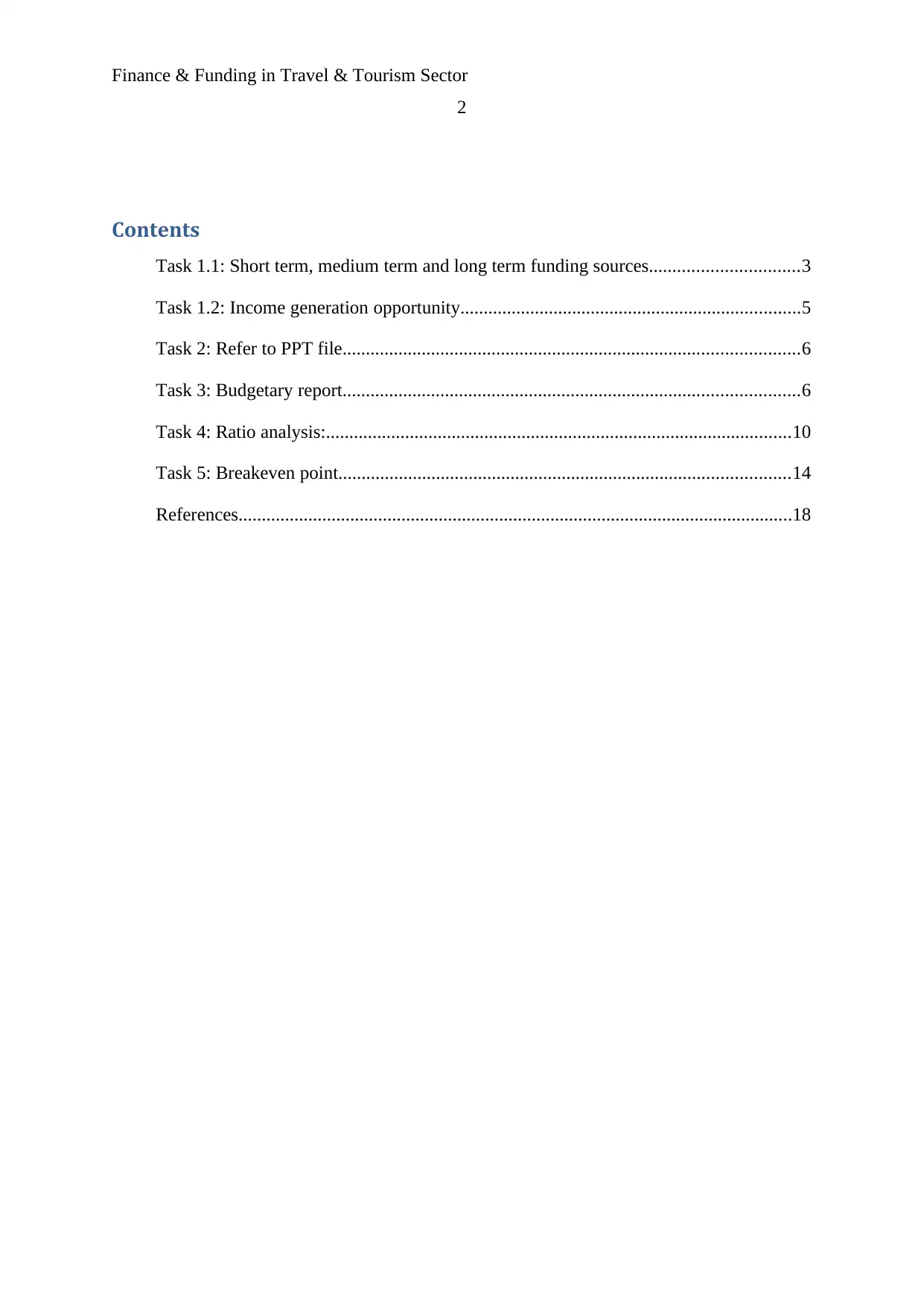
Finance & Funding in Travel & Tourism Sector
2
Contents
Task 1.1: Short term, medium term and long term funding sources................................3
Task 1.2: Income generation opportunity.........................................................................5
Task 2: Refer to PPT file..................................................................................................6
Task 3: Budgetary report..................................................................................................6
Task 4: Ratio analysis:....................................................................................................10
Task 5: Breakeven point.................................................................................................14
References.......................................................................................................................18
2
Contents
Task 1.1: Short term, medium term and long term funding sources................................3
Task 1.2: Income generation opportunity.........................................................................5
Task 2: Refer to PPT file..................................................................................................6
Task 3: Budgetary report..................................................................................................6
Task 4: Ratio analysis:....................................................................................................10
Task 5: Breakeven point.................................................................................................14
References.......................................................................................................................18
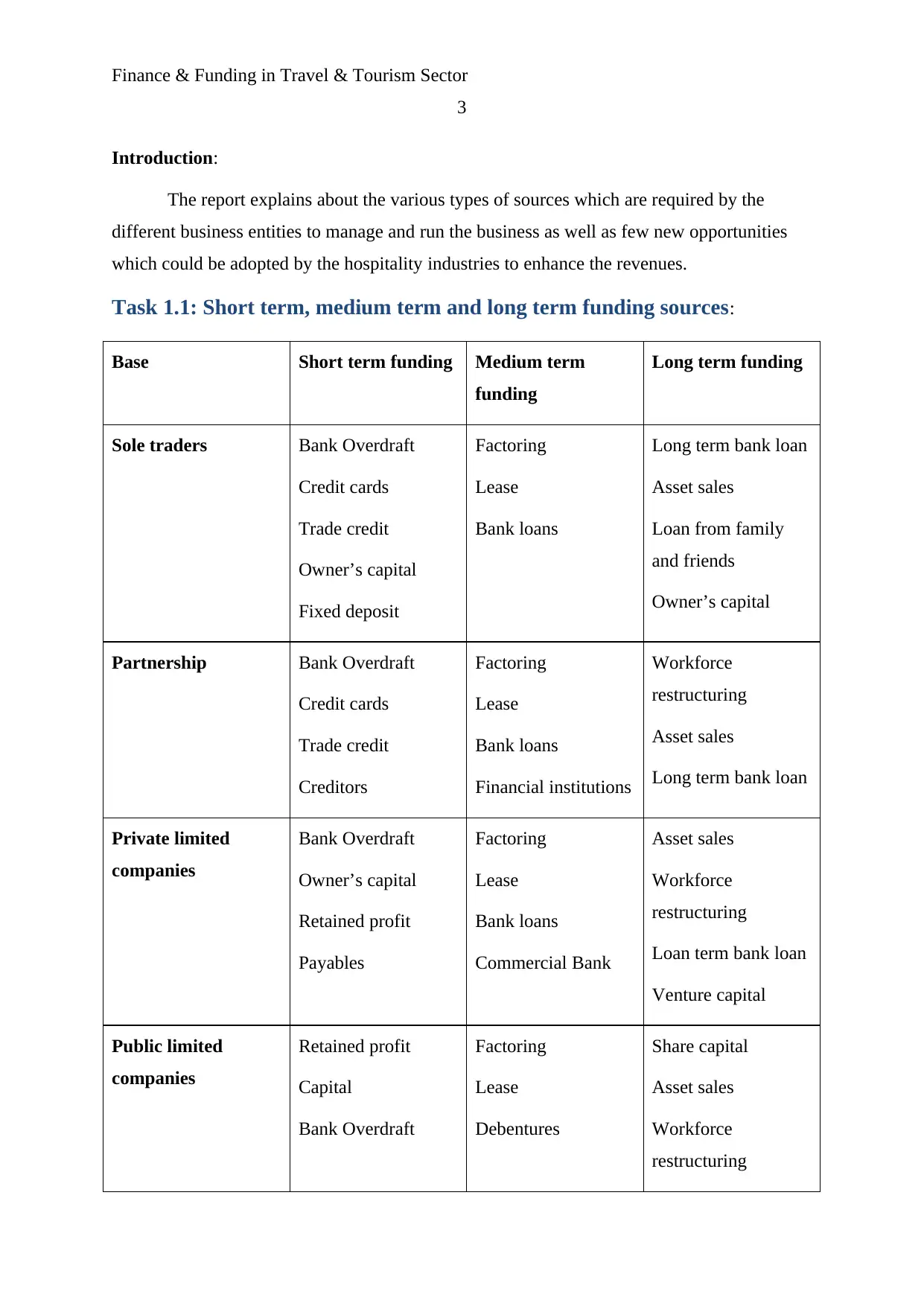
Finance & Funding in Travel & Tourism Sector
3
Introduction:
The report explains about the various types of sources which are required by the
different business entities to manage and run the business as well as few new opportunities
which could be adopted by the hospitality industries to enhance the revenues.
Task 1.1: Short term, medium term and long term funding sources:
Base Short term funding Medium term
funding
Long term funding
Sole traders Bank Overdraft
Credit cards
Trade credit
Owner’s capital
Fixed deposit
Factoring
Lease
Bank loans
Long term bank loan
Asset sales
Loan from family
and friends
Owner’s capital
Partnership Bank Overdraft
Credit cards
Trade credit
Creditors
Factoring
Lease
Bank loans
Financial institutions
Workforce
restructuring
Asset sales
Long term bank loan
Private limited
companies
Bank Overdraft
Owner’s capital
Retained profit
Payables
Factoring
Lease
Bank loans
Commercial Bank
Asset sales
Workforce
restructuring
Loan term bank loan
Venture capital
Public limited
companies
Retained profit
Capital
Bank Overdraft
Factoring
Lease
Debentures
Share capital
Asset sales
Workforce
restructuring
3
Introduction:
The report explains about the various types of sources which are required by the
different business entities to manage and run the business as well as few new opportunities
which could be adopted by the hospitality industries to enhance the revenues.
Task 1.1: Short term, medium term and long term funding sources:
Base Short term funding Medium term
funding
Long term funding
Sole traders Bank Overdraft
Credit cards
Trade credit
Owner’s capital
Fixed deposit
Factoring
Lease
Bank loans
Long term bank loan
Asset sales
Loan from family
and friends
Owner’s capital
Partnership Bank Overdraft
Credit cards
Trade credit
Creditors
Factoring
Lease
Bank loans
Financial institutions
Workforce
restructuring
Asset sales
Long term bank loan
Private limited
companies
Bank Overdraft
Owner’s capital
Retained profit
Payables
Factoring
Lease
Bank loans
Commercial Bank
Asset sales
Workforce
restructuring
Loan term bank loan
Venture capital
Public limited
companies
Retained profit
Capital
Bank Overdraft
Factoring
Lease
Debentures
Share capital
Asset sales
Workforce
restructuring
⊘ This is a preview!⊘
Do you want full access?
Subscribe today to unlock all pages.

Trusted by 1+ million students worldwide
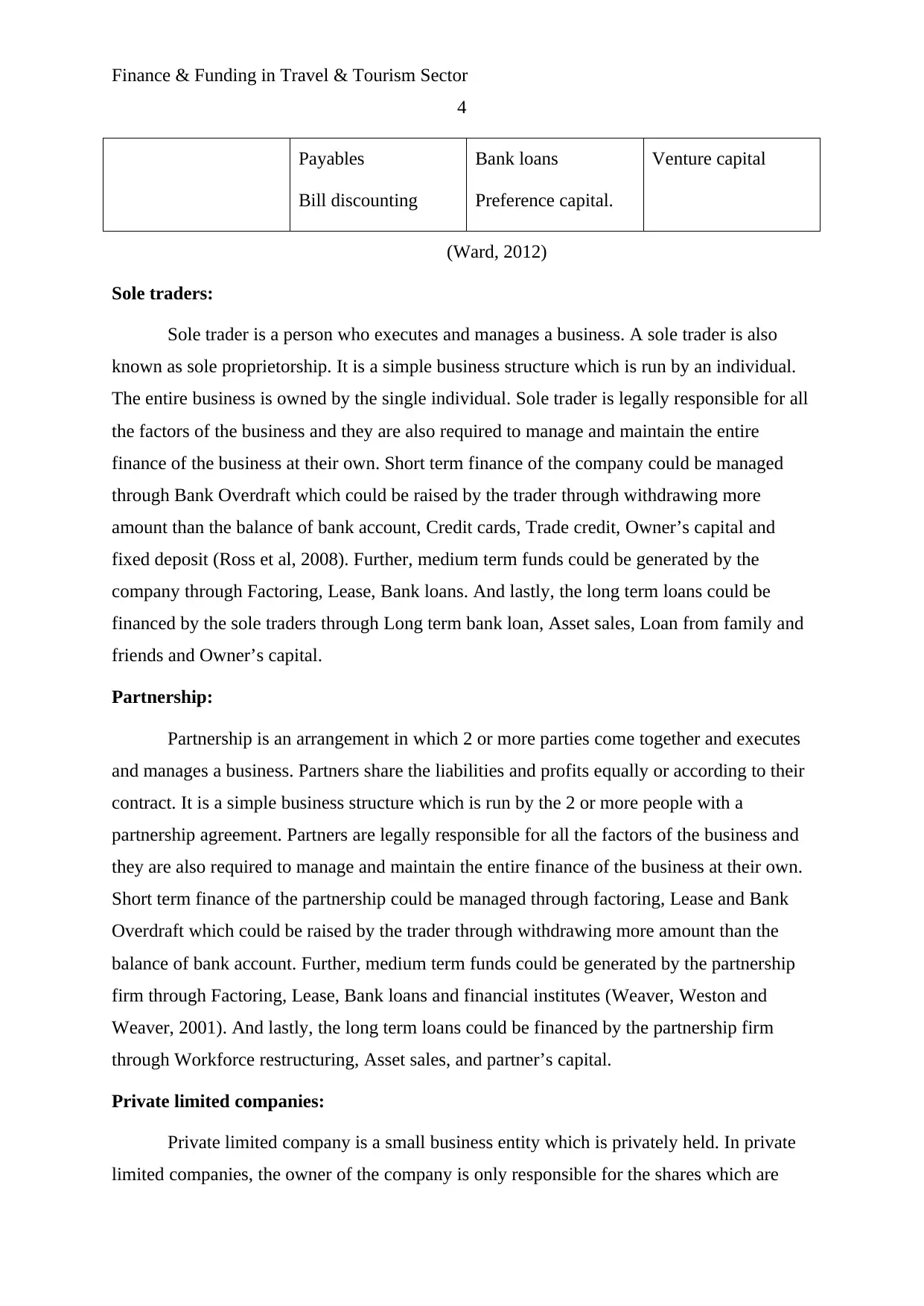
Finance & Funding in Travel & Tourism Sector
4
Payables
Bill discounting
Bank loans
Preference capital.
Venture capital
(Ward, 2012)
Sole traders:
Sole trader is a person who executes and manages a business. A sole trader is also
known as sole proprietorship. It is a simple business structure which is run by an individual.
The entire business is owned by the single individual. Sole trader is legally responsible for all
the factors of the business and they are also required to manage and maintain the entire
finance of the business at their own. Short term finance of the company could be managed
through Bank Overdraft which could be raised by the trader through withdrawing more
amount than the balance of bank account, Credit cards, Trade credit, Owner’s capital and
fixed deposit (Ross et al, 2008). Further, medium term funds could be generated by the
company through Factoring, Lease, Bank loans. And lastly, the long term loans could be
financed by the sole traders through Long term bank loan, Asset sales, Loan from family and
friends and Owner’s capital.
Partnership:
Partnership is an arrangement in which 2 or more parties come together and executes
and manages a business. Partners share the liabilities and profits equally or according to their
contract. It is a simple business structure which is run by the 2 or more people with a
partnership agreement. Partners are legally responsible for all the factors of the business and
they are also required to manage and maintain the entire finance of the business at their own.
Short term finance of the partnership could be managed through factoring, Lease and Bank
Overdraft which could be raised by the trader through withdrawing more amount than the
balance of bank account. Further, medium term funds could be generated by the partnership
firm through Factoring, Lease, Bank loans and financial institutes (Weaver, Weston and
Weaver, 2001). And lastly, the long term loans could be financed by the partnership firm
through Workforce restructuring, Asset sales, and partner’s capital.
Private limited companies:
Private limited company is a small business entity which is privately held. In private
limited companies, the owner of the company is only responsible for the shares which are
4
Payables
Bill discounting
Bank loans
Preference capital.
Venture capital
(Ward, 2012)
Sole traders:
Sole trader is a person who executes and manages a business. A sole trader is also
known as sole proprietorship. It is a simple business structure which is run by an individual.
The entire business is owned by the single individual. Sole trader is legally responsible for all
the factors of the business and they are also required to manage and maintain the entire
finance of the business at their own. Short term finance of the company could be managed
through Bank Overdraft which could be raised by the trader through withdrawing more
amount than the balance of bank account, Credit cards, Trade credit, Owner’s capital and
fixed deposit (Ross et al, 2008). Further, medium term funds could be generated by the
company through Factoring, Lease, Bank loans. And lastly, the long term loans could be
financed by the sole traders through Long term bank loan, Asset sales, Loan from family and
friends and Owner’s capital.
Partnership:
Partnership is an arrangement in which 2 or more parties come together and executes
and manages a business. Partners share the liabilities and profits equally or according to their
contract. It is a simple business structure which is run by the 2 or more people with a
partnership agreement. Partners are legally responsible for all the factors of the business and
they are also required to manage and maintain the entire finance of the business at their own.
Short term finance of the partnership could be managed through factoring, Lease and Bank
Overdraft which could be raised by the trader through withdrawing more amount than the
balance of bank account. Further, medium term funds could be generated by the partnership
firm through Factoring, Lease, Bank loans and financial institutes (Weaver, Weston and
Weaver, 2001). And lastly, the long term loans could be financed by the partnership firm
through Workforce restructuring, Asset sales, and partner’s capital.
Private limited companies:
Private limited company is a small business entity which is privately held. In private
limited companies, the owner of the company is only responsible for the shares which are
Paraphrase This Document
Need a fresh take? Get an instant paraphrase of this document with our AI Paraphraser
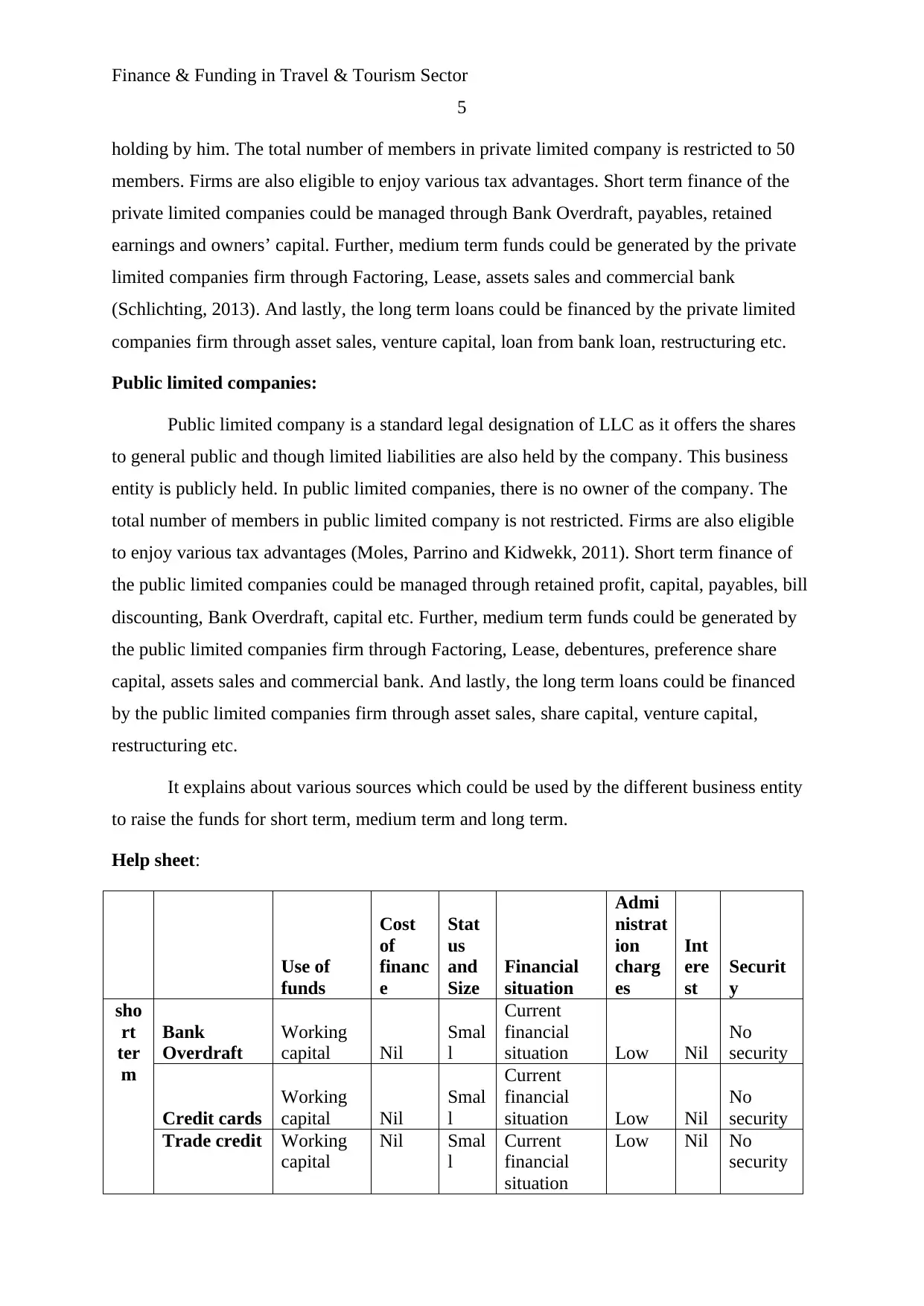
Finance & Funding in Travel & Tourism Sector
5
holding by him. The total number of members in private limited company is restricted to 50
members. Firms are also eligible to enjoy various tax advantages. Short term finance of the
private limited companies could be managed through Bank Overdraft, payables, retained
earnings and owners’ capital. Further, medium term funds could be generated by the private
limited companies firm through Factoring, Lease, assets sales and commercial bank
(Schlichting, 2013). And lastly, the long term loans could be financed by the private limited
companies firm through asset sales, venture capital, loan from bank loan, restructuring etc.
Public limited companies:
Public limited company is a standard legal designation of LLC as it offers the shares
to general public and though limited liabilities are also held by the company. This business
entity is publicly held. In public limited companies, there is no owner of the company. The
total number of members in public limited company is not restricted. Firms are also eligible
to enjoy various tax advantages (Moles, Parrino and Kidwekk, 2011). Short term finance of
the public limited companies could be managed through retained profit, capital, payables, bill
discounting, Bank Overdraft, capital etc. Further, medium term funds could be generated by
the public limited companies firm through Factoring, Lease, debentures, preference share
capital, assets sales and commercial bank. And lastly, the long term loans could be financed
by the public limited companies firm through asset sales, share capital, venture capital,
restructuring etc.
It explains about various sources which could be used by the different business entity
to raise the funds for short term, medium term and long term.
Help sheet:
Use of
funds
Cost
of
financ
e
Stat
us
and
Size
Financial
situation
Admi
nistrat
ion
charg
es
Int
ere
st
Securit
y
sho
rt
ter
m
Bank
Overdraft
Working
capital Nil
Smal
l
Current
financial
situation Low Nil
No
security
Credit cards
Working
capital Nil
Smal
l
Current
financial
situation Low Nil
No
security
Trade credit Working
capital
Nil Smal
l
Current
financial
situation
Low Nil No
security
5
holding by him. The total number of members in private limited company is restricted to 50
members. Firms are also eligible to enjoy various tax advantages. Short term finance of the
private limited companies could be managed through Bank Overdraft, payables, retained
earnings and owners’ capital. Further, medium term funds could be generated by the private
limited companies firm through Factoring, Lease, assets sales and commercial bank
(Schlichting, 2013). And lastly, the long term loans could be financed by the private limited
companies firm through asset sales, venture capital, loan from bank loan, restructuring etc.
Public limited companies:
Public limited company is a standard legal designation of LLC as it offers the shares
to general public and though limited liabilities are also held by the company. This business
entity is publicly held. In public limited companies, there is no owner of the company. The
total number of members in public limited company is not restricted. Firms are also eligible
to enjoy various tax advantages (Moles, Parrino and Kidwekk, 2011). Short term finance of
the public limited companies could be managed through retained profit, capital, payables, bill
discounting, Bank Overdraft, capital etc. Further, medium term funds could be generated by
the public limited companies firm through Factoring, Lease, debentures, preference share
capital, assets sales and commercial bank. And lastly, the long term loans could be financed
by the public limited companies firm through asset sales, share capital, venture capital,
restructuring etc.
It explains about various sources which could be used by the different business entity
to raise the funds for short term, medium term and long term.
Help sheet:
Use of
funds
Cost
of
financ
e
Stat
us
and
Size
Financial
situation
Admi
nistrat
ion
charg
es
Int
ere
st
Securit
y
sho
rt
ter
m
Bank
Overdraft
Working
capital Nil
Smal
l
Current
financial
situation Low Nil
No
security
Credit cards
Working
capital Nil
Smal
l
Current
financial
situation Low Nil
No
security
Trade credit Working
capital
Nil Smal
l
Current
financial
situation
Low Nil No
security
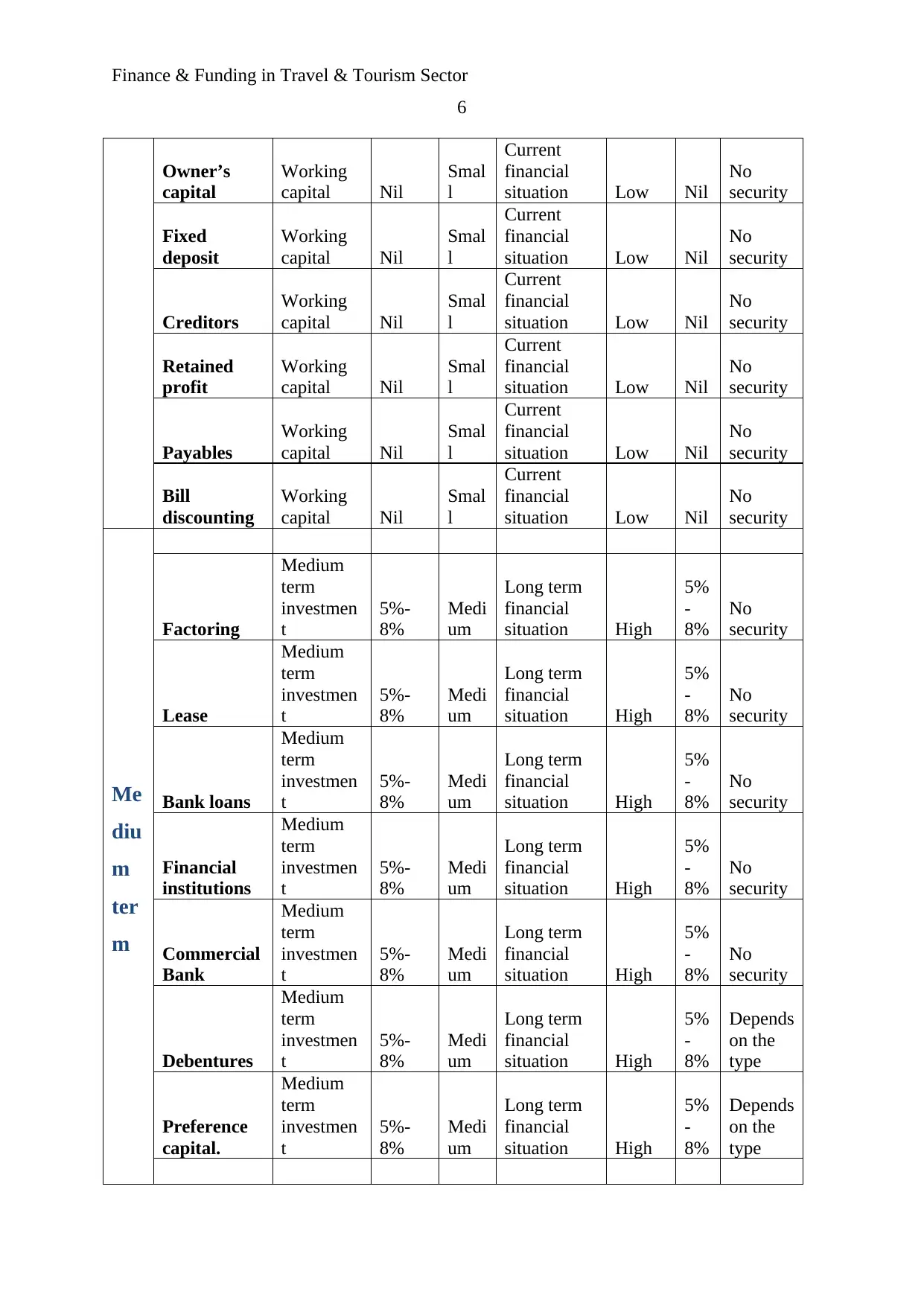
Finance & Funding in Travel & Tourism Sector
6
Owner’s
capital
Working
capital Nil
Smal
l
Current
financial
situation Low Nil
No
security
Fixed
deposit
Working
capital Nil
Smal
l
Current
financial
situation Low Nil
No
security
Creditors
Working
capital Nil
Smal
l
Current
financial
situation Low Nil
No
security
Retained
profit
Working
capital Nil
Smal
l
Current
financial
situation Low Nil
No
security
Payables
Working
capital Nil
Smal
l
Current
financial
situation Low Nil
No
security
Bill
discounting
Working
capital Nil
Smal
l
Current
financial
situation Low Nil
No
security
Me
diu
m
ter
m
Factoring
Medium
term
investmen
t
5%-
8%
Medi
um
Long term
financial
situation High
5%
-
8%
No
security
Lease
Medium
term
investmen
t
5%-
8%
Medi
um
Long term
financial
situation High
5%
-
8%
No
security
Bank loans
Medium
term
investmen
t
5%-
8%
Medi
um
Long term
financial
situation High
5%
-
8%
No
security
Financial
institutions
Medium
term
investmen
t
5%-
8%
Medi
um
Long term
financial
situation High
5%
-
8%
No
security
Commercial
Bank
Medium
term
investmen
t
5%-
8%
Medi
um
Long term
financial
situation High
5%
-
8%
No
security
Debentures
Medium
term
investmen
t
5%-
8%
Medi
um
Long term
financial
situation High
5%
-
8%
Depends
on the
type
Preference
capital.
Medium
term
investmen
t
5%-
8%
Medi
um
Long term
financial
situation High
5%
-
8%
Depends
on the
type
6
Owner’s
capital
Working
capital Nil
Smal
l
Current
financial
situation Low Nil
No
security
Fixed
deposit
Working
capital Nil
Smal
l
Current
financial
situation Low Nil
No
security
Creditors
Working
capital Nil
Smal
l
Current
financial
situation Low Nil
No
security
Retained
profit
Working
capital Nil
Smal
l
Current
financial
situation Low Nil
No
security
Payables
Working
capital Nil
Smal
l
Current
financial
situation Low Nil
No
security
Bill
discounting
Working
capital Nil
Smal
l
Current
financial
situation Low Nil
No
security
Me
diu
m
ter
m
Factoring
Medium
term
investmen
t
5%-
8%
Medi
um
Long term
financial
situation High
5%
-
8%
No
security
Lease
Medium
term
investmen
t
5%-
8%
Medi
um
Long term
financial
situation High
5%
-
8%
No
security
Bank loans
Medium
term
investmen
t
5%-
8%
Medi
um
Long term
financial
situation High
5%
-
8%
No
security
Financial
institutions
Medium
term
investmen
t
5%-
8%
Medi
um
Long term
financial
situation High
5%
-
8%
No
security
Commercial
Bank
Medium
term
investmen
t
5%-
8%
Medi
um
Long term
financial
situation High
5%
-
8%
No
security
Debentures
Medium
term
investmen
t
5%-
8%
Medi
um
Long term
financial
situation High
5%
-
8%
Depends
on the
type
Preference
capital.
Medium
term
investmen
t
5%-
8%
Medi
um
Long term
financial
situation High
5%
-
8%
Depends
on the
type
⊘ This is a preview!⊘
Do you want full access?
Subscribe today to unlock all pages.

Trusted by 1+ million students worldwide
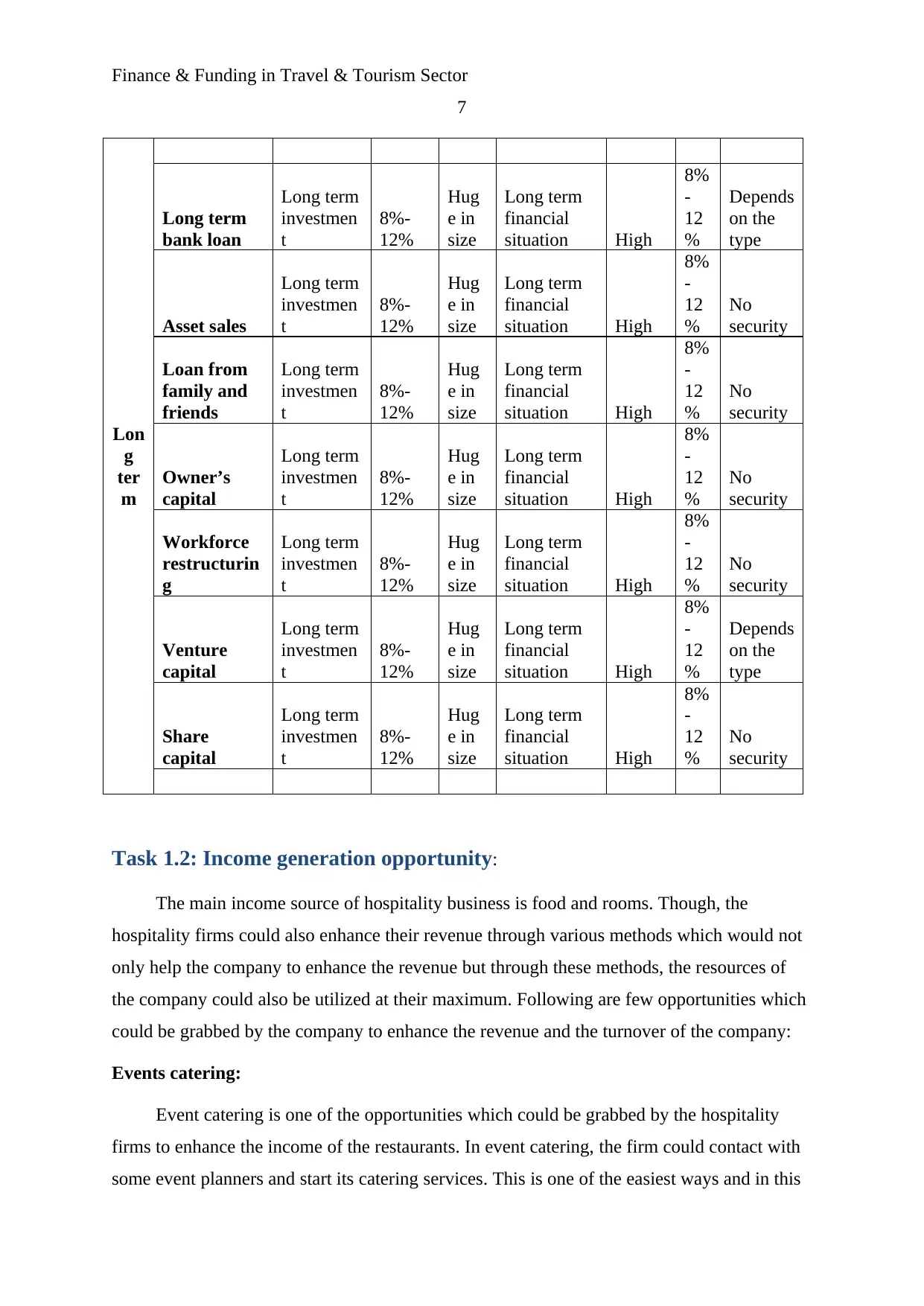
Finance & Funding in Travel & Tourism Sector
7
Lon
g
ter
m
Long term
bank loan
Long term
investmen
t
8%-
12%
Hug
e in
size
Long term
financial
situation High
8%
-
12
%
Depends
on the
type
Asset sales
Long term
investmen
t
8%-
12%
Hug
e in
size
Long term
financial
situation High
8%
-
12
%
No
security
Loan from
family and
friends
Long term
investmen
t
8%-
12%
Hug
e in
size
Long term
financial
situation High
8%
-
12
%
No
security
Owner’s
capital
Long term
investmen
t
8%-
12%
Hug
e in
size
Long term
financial
situation High
8%
-
12
%
No
security
Workforce
restructurin
g
Long term
investmen
t
8%-
12%
Hug
e in
size
Long term
financial
situation High
8%
-
12
%
No
security
Venture
capital
Long term
investmen
t
8%-
12%
Hug
e in
size
Long term
financial
situation High
8%
-
12
%
Depends
on the
type
Share
capital
Long term
investmen
t
8%-
12%
Hug
e in
size
Long term
financial
situation High
8%
-
12
%
No
security
Task 1.2: Income generation opportunity:
The main income source of hospitality business is food and rooms. Though, the
hospitality firms could also enhance their revenue through various methods which would not
only help the company to enhance the revenue but through these methods, the resources of
the company could also be utilized at their maximum. Following are few opportunities which
could be grabbed by the company to enhance the revenue and the turnover of the company:
Events catering:
Event catering is one of the opportunities which could be grabbed by the hospitality
firms to enhance the income of the restaurants. In event catering, the firm could contact with
some event planners and start its catering services. This is one of the easiest ways and in this
7
Lon
g
ter
m
Long term
bank loan
Long term
investmen
t
8%-
12%
Hug
e in
size
Long term
financial
situation High
8%
-
12
%
Depends
on the
type
Asset sales
Long term
investmen
t
8%-
12%
Hug
e in
size
Long term
financial
situation High
8%
-
12
%
No
security
Loan from
family and
friends
Long term
investmen
t
8%-
12%
Hug
e in
size
Long term
financial
situation High
8%
-
12
%
No
security
Owner’s
capital
Long term
investmen
t
8%-
12%
Hug
e in
size
Long term
financial
situation High
8%
-
12
%
No
security
Workforce
restructurin
g
Long term
investmen
t
8%-
12%
Hug
e in
size
Long term
financial
situation High
8%
-
12
%
No
security
Venture
capital
Long term
investmen
t
8%-
12%
Hug
e in
size
Long term
financial
situation High
8%
-
12
%
Depends
on the
type
Share
capital
Long term
investmen
t
8%-
12%
Hug
e in
size
Long term
financial
situation High
8%
-
12
%
No
security
Task 1.2: Income generation opportunity:
The main income source of hospitality business is food and rooms. Though, the
hospitality firms could also enhance their revenue through various methods which would not
only help the company to enhance the revenue but through these methods, the resources of
the company could also be utilized at their maximum. Following are few opportunities which
could be grabbed by the company to enhance the revenue and the turnover of the company:
Events catering:
Event catering is one of the opportunities which could be grabbed by the hospitality
firms to enhance the income of the restaurants. In event catering, the firm could contact with
some event planners and start its catering services. This is one of the easiest ways and in this
Paraphrase This Document
Need a fresh take? Get an instant paraphrase of this document with our AI Paraphraser
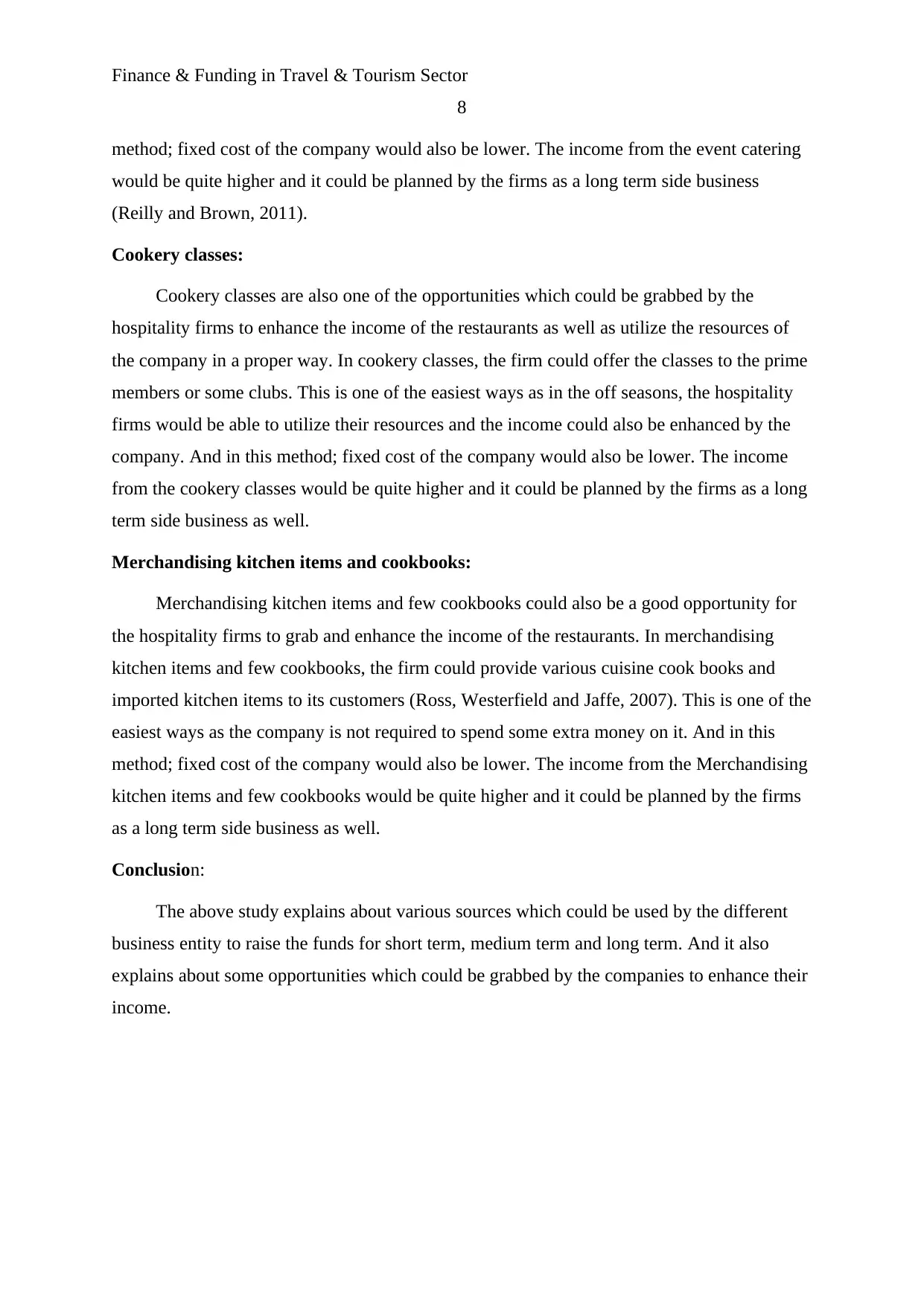
Finance & Funding in Travel & Tourism Sector
8
method; fixed cost of the company would also be lower. The income from the event catering
would be quite higher and it could be planned by the firms as a long term side business
(Reilly and Brown, 2011).
Cookery classes:
Cookery classes are also one of the opportunities which could be grabbed by the
hospitality firms to enhance the income of the restaurants as well as utilize the resources of
the company in a proper way. In cookery classes, the firm could offer the classes to the prime
members or some clubs. This is one of the easiest ways as in the off seasons, the hospitality
firms would be able to utilize their resources and the income could also be enhanced by the
company. And in this method; fixed cost of the company would also be lower. The income
from the cookery classes would be quite higher and it could be planned by the firms as a long
term side business as well.
Merchandising kitchen items and cookbooks:
Merchandising kitchen items and few cookbooks could also be a good opportunity for
the hospitality firms to grab and enhance the income of the restaurants. In merchandising
kitchen items and few cookbooks, the firm could provide various cuisine cook books and
imported kitchen items to its customers (Ross, Westerfield and Jaffe, 2007). This is one of the
easiest ways as the company is not required to spend some extra money on it. And in this
method; fixed cost of the company would also be lower. The income from the Merchandising
kitchen items and few cookbooks would be quite higher and it could be planned by the firms
as a long term side business as well.
Conclusion:
The above study explains about various sources which could be used by the different
business entity to raise the funds for short term, medium term and long term. And it also
explains about some opportunities which could be grabbed by the companies to enhance their
income.
8
method; fixed cost of the company would also be lower. The income from the event catering
would be quite higher and it could be planned by the firms as a long term side business
(Reilly and Brown, 2011).
Cookery classes:
Cookery classes are also one of the opportunities which could be grabbed by the
hospitality firms to enhance the income of the restaurants as well as utilize the resources of
the company in a proper way. In cookery classes, the firm could offer the classes to the prime
members or some clubs. This is one of the easiest ways as in the off seasons, the hospitality
firms would be able to utilize their resources and the income could also be enhanced by the
company. And in this method; fixed cost of the company would also be lower. The income
from the cookery classes would be quite higher and it could be planned by the firms as a long
term side business as well.
Merchandising kitchen items and cookbooks:
Merchandising kitchen items and few cookbooks could also be a good opportunity for
the hospitality firms to grab and enhance the income of the restaurants. In merchandising
kitchen items and few cookbooks, the firm could provide various cuisine cook books and
imported kitchen items to its customers (Ross, Westerfield and Jaffe, 2007). This is one of the
easiest ways as the company is not required to spend some extra money on it. And in this
method; fixed cost of the company would also be lower. The income from the Merchandising
kitchen items and few cookbooks would be quite higher and it could be planned by the firms
as a long term side business as well.
Conclusion:
The above study explains about various sources which could be used by the different
business entity to raise the funds for short term, medium term and long term. And it also
explains about some opportunities which could be grabbed by the companies to enhance their
income.
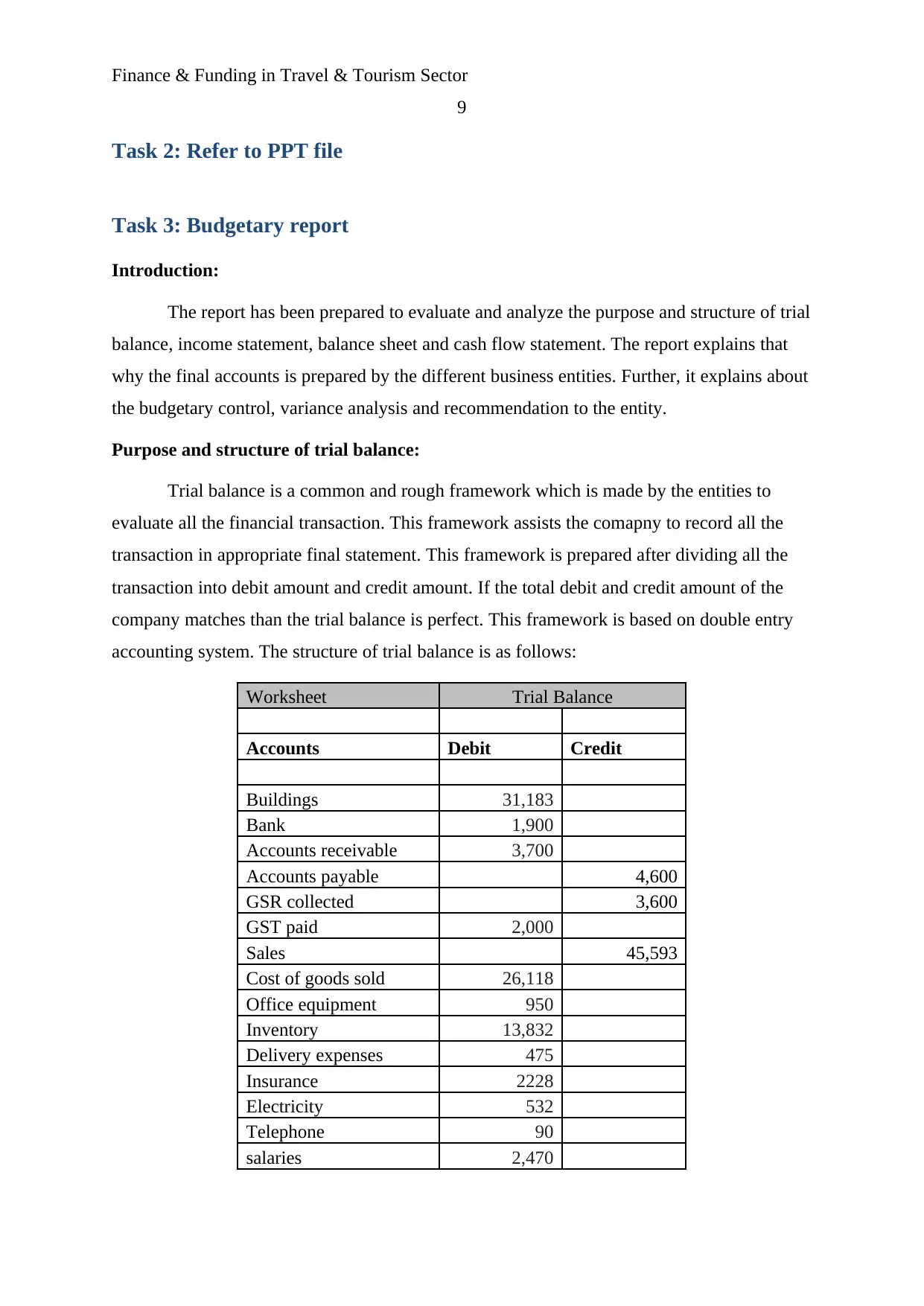
Finance & Funding in Travel & Tourism Sector
9
Task 2: Refer to PPT file
Task 3: Budgetary report
Introduction:
The report has been prepared to evaluate and analyze the purpose and structure of trial
balance, income statement, balance sheet and cash flow statement. The report explains that
why the final accounts is prepared by the different business entities. Further, it explains about
the budgetary control, variance analysis and recommendation to the entity.
Purpose and structure of trial balance:
Trial balance is a common and rough framework which is made by the entities to
evaluate all the financial transaction. This framework assists the comapny to record all the
transaction in appropriate final statement. This framework is prepared after dividing all the
transaction into debit amount and credit amount. If the total debit and credit amount of the
company matches than the trial balance is perfect. This framework is based on double entry
accounting system. The structure of trial balance is as follows:
Worksheet Trial Balance
Accounts Debit Credit
Buildings 31,183
Bank 1,900
Accounts receivable 3,700
Accounts payable 4,600
GSR collected 3,600
GST paid 2,000
Sales 45,593
Cost of goods sold 26,118
Office equipment 950
Inventory 13,832
Delivery expenses 475
Insurance 2228
Electricity 532
Telephone 90
salaries 2,470
9
Task 2: Refer to PPT file
Task 3: Budgetary report
Introduction:
The report has been prepared to evaluate and analyze the purpose and structure of trial
balance, income statement, balance sheet and cash flow statement. The report explains that
why the final accounts is prepared by the different business entities. Further, it explains about
the budgetary control, variance analysis and recommendation to the entity.
Purpose and structure of trial balance:
Trial balance is a common and rough framework which is made by the entities to
evaluate all the financial transaction. This framework assists the comapny to record all the
transaction in appropriate final statement. This framework is prepared after dividing all the
transaction into debit amount and credit amount. If the total debit and credit amount of the
company matches than the trial balance is perfect. This framework is based on double entry
accounting system. The structure of trial balance is as follows:
Worksheet Trial Balance
Accounts Debit Credit
Buildings 31,183
Bank 1,900
Accounts receivable 3,700
Accounts payable 4,600
GSR collected 3,600
GST paid 2,000
Sales 45,593
Cost of goods sold 26,118
Office equipment 950
Inventory 13,832
Delivery expenses 475
Insurance 2228
Electricity 532
Telephone 90
salaries 2,470
⊘ This is a preview!⊘
Do you want full access?
Subscribe today to unlock all pages.

Trusted by 1+ million students worldwide
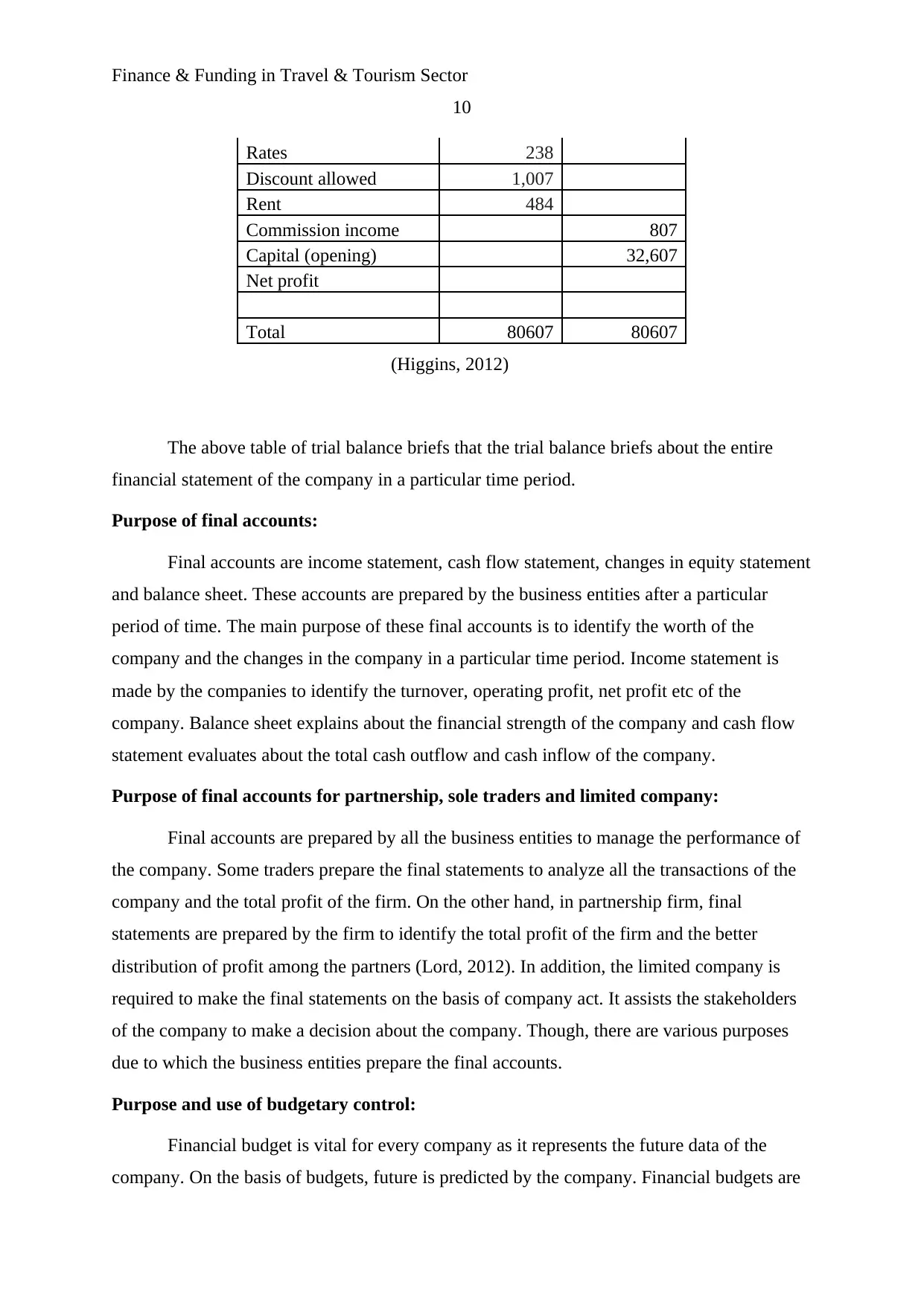
Finance & Funding in Travel & Tourism Sector
10
Rates 238
Discount allowed 1,007
Rent 484
Commission income 807
Capital (opening) 32,607
Net profit
Total 80607 80607
(Higgins, 2012)
The above table of trial balance briefs that the trial balance briefs about the entire
financial statement of the company in a particular time period.
Purpose of final accounts:
Final accounts are income statement, cash flow statement, changes in equity statement
and balance sheet. These accounts are prepared by the business entities after a particular
period of time. The main purpose of these final accounts is to identify the worth of the
company and the changes in the company in a particular time period. Income statement is
made by the companies to identify the turnover, operating profit, net profit etc of the
company. Balance sheet explains about the financial strength of the company and cash flow
statement evaluates about the total cash outflow and cash inflow of the company.
Purpose of final accounts for partnership, sole traders and limited company:
Final accounts are prepared by all the business entities to manage the performance of
the company. Some traders prepare the final statements to analyze all the transactions of the
company and the total profit of the firm. On the other hand, in partnership firm, final
statements are prepared by the firm to identify the total profit of the firm and the better
distribution of profit among the partners (Lord, 2012). In addition, the limited company is
required to make the final statements on the basis of company act. It assists the stakeholders
of the company to make a decision about the company. Though, there are various purposes
due to which the business entities prepare the final accounts.
Purpose and use of budgetary control:
Financial budget is vital for every company as it represents the future data of the
company. On the basis of budgets, future is predicted by the company. Financial budgets are
10
Rates 238
Discount allowed 1,007
Rent 484
Commission income 807
Capital (opening) 32,607
Net profit
Total 80607 80607
(Higgins, 2012)
The above table of trial balance briefs that the trial balance briefs about the entire
financial statement of the company in a particular time period.
Purpose of final accounts:
Final accounts are income statement, cash flow statement, changes in equity statement
and balance sheet. These accounts are prepared by the business entities after a particular
period of time. The main purpose of these final accounts is to identify the worth of the
company and the changes in the company in a particular time period. Income statement is
made by the companies to identify the turnover, operating profit, net profit etc of the
company. Balance sheet explains about the financial strength of the company and cash flow
statement evaluates about the total cash outflow and cash inflow of the company.
Purpose of final accounts for partnership, sole traders and limited company:
Final accounts are prepared by all the business entities to manage the performance of
the company. Some traders prepare the final statements to analyze all the transactions of the
company and the total profit of the firm. On the other hand, in partnership firm, final
statements are prepared by the firm to identify the total profit of the firm and the better
distribution of profit among the partners (Lord, 2012). In addition, the limited company is
required to make the final statements on the basis of company act. It assists the stakeholders
of the company to make a decision about the company. Though, there are various purposes
due to which the business entities prepare the final accounts.
Purpose and use of budgetary control:
Financial budget is vital for every company as it represents the future data of the
company. On the basis of budgets, future is predicted by the company. Financial budgets are
Paraphrase This Document
Need a fresh take? Get an instant paraphrase of this document with our AI Paraphraser
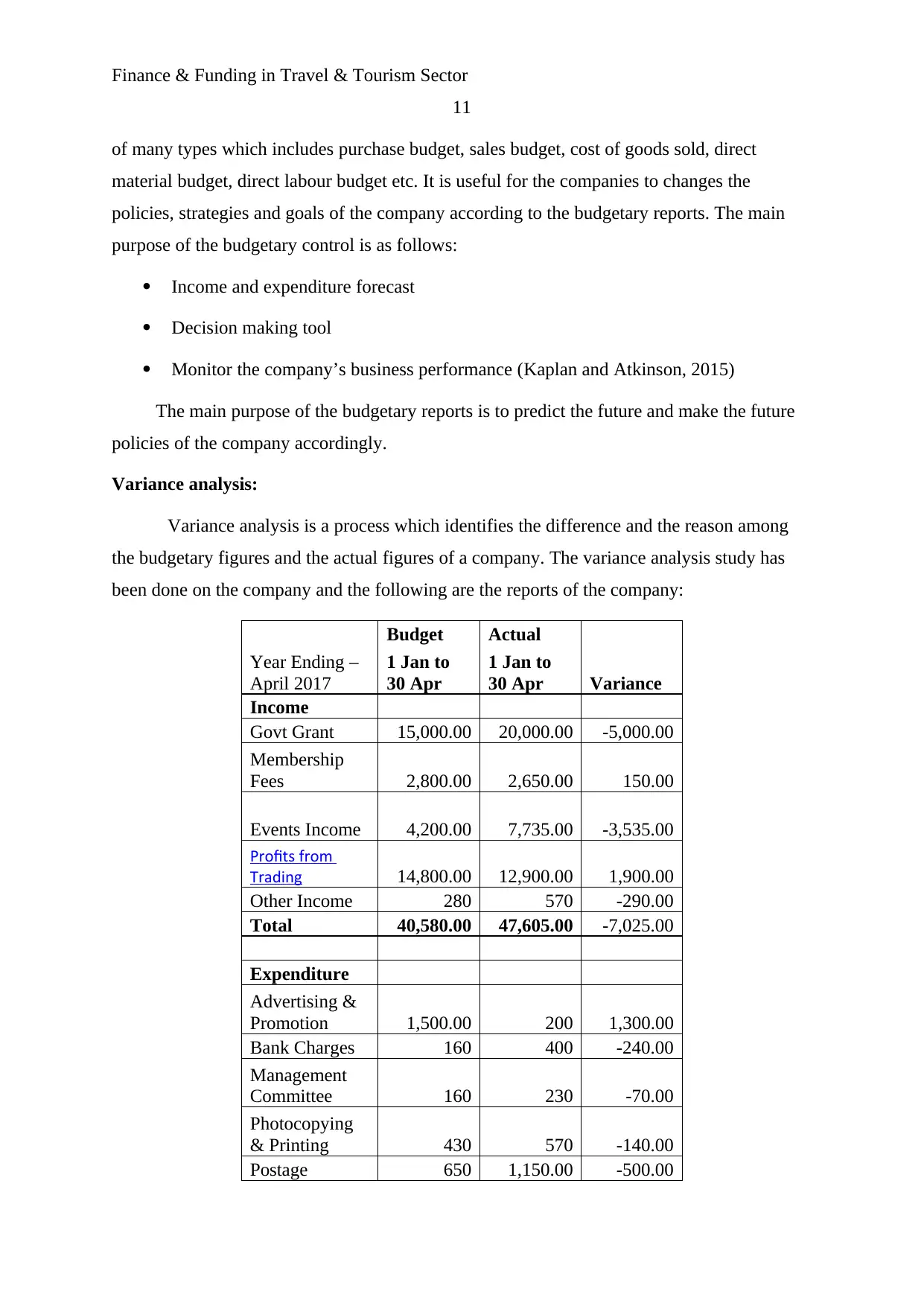
Finance & Funding in Travel & Tourism Sector
11
of many types which includes purchase budget, sales budget, cost of goods sold, direct
material budget, direct labour budget etc. It is useful for the companies to changes the
policies, strategies and goals of the company according to the budgetary reports. The main
purpose of the budgetary control is as follows:
Income and expenditure forecast
Decision making tool
Monitor the company’s business performance (Kaplan and Atkinson, 2015)
The main purpose of the budgetary reports is to predict the future and make the future
policies of the company accordingly.
Variance analysis:
Variance analysis is a process which identifies the difference and the reason among
the budgetary figures and the actual figures of a company. The variance analysis study has
been done on the company and the following are the reports of the company:
Year Ending –
April 2017
Budget Actual
Variance
1 Jan to
30 Apr
1 Jan to
30 Apr
Income
Govt Grant 15,000.00 20,000.00 -5,000.00
Membership
Fees 2,800.00 2,650.00 150.00
Events Income 4,200.00 7,735.00 -3,535.00
Profits from
Trading 14,800.00 12,900.00 1,900.00
Other Income 280 570 -290.00
Total 40,580.00 47,605.00 -7,025.00
Expenditure
Advertising &
Promotion 1,500.00 200 1,300.00
Bank Charges 160 400 -240.00
Management
Committee 160 230 -70.00
Photocopying
& Printing 430 570 -140.00
Postage 650 1,150.00 -500.00
11
of many types which includes purchase budget, sales budget, cost of goods sold, direct
material budget, direct labour budget etc. It is useful for the companies to changes the
policies, strategies and goals of the company according to the budgetary reports. The main
purpose of the budgetary control is as follows:
Income and expenditure forecast
Decision making tool
Monitor the company’s business performance (Kaplan and Atkinson, 2015)
The main purpose of the budgetary reports is to predict the future and make the future
policies of the company accordingly.
Variance analysis:
Variance analysis is a process which identifies the difference and the reason among
the budgetary figures and the actual figures of a company. The variance analysis study has
been done on the company and the following are the reports of the company:
Year Ending –
April 2017
Budget Actual
Variance
1 Jan to
30 Apr
1 Jan to
30 Apr
Income
Govt Grant 15,000.00 20,000.00 -5,000.00
Membership
Fees 2,800.00 2,650.00 150.00
Events Income 4,200.00 7,735.00 -3,535.00
Profits from
Trading 14,800.00 12,900.00 1,900.00
Other Income 280 570 -290.00
Total 40,580.00 47,605.00 -7,025.00
Expenditure
Advertising &
Promotion 1,500.00 200 1,300.00
Bank Charges 160 400 -240.00
Management
Committee 160 230 -70.00
Photocopying
& Printing 430 570 -140.00
Postage 650 1,150.00 -500.00
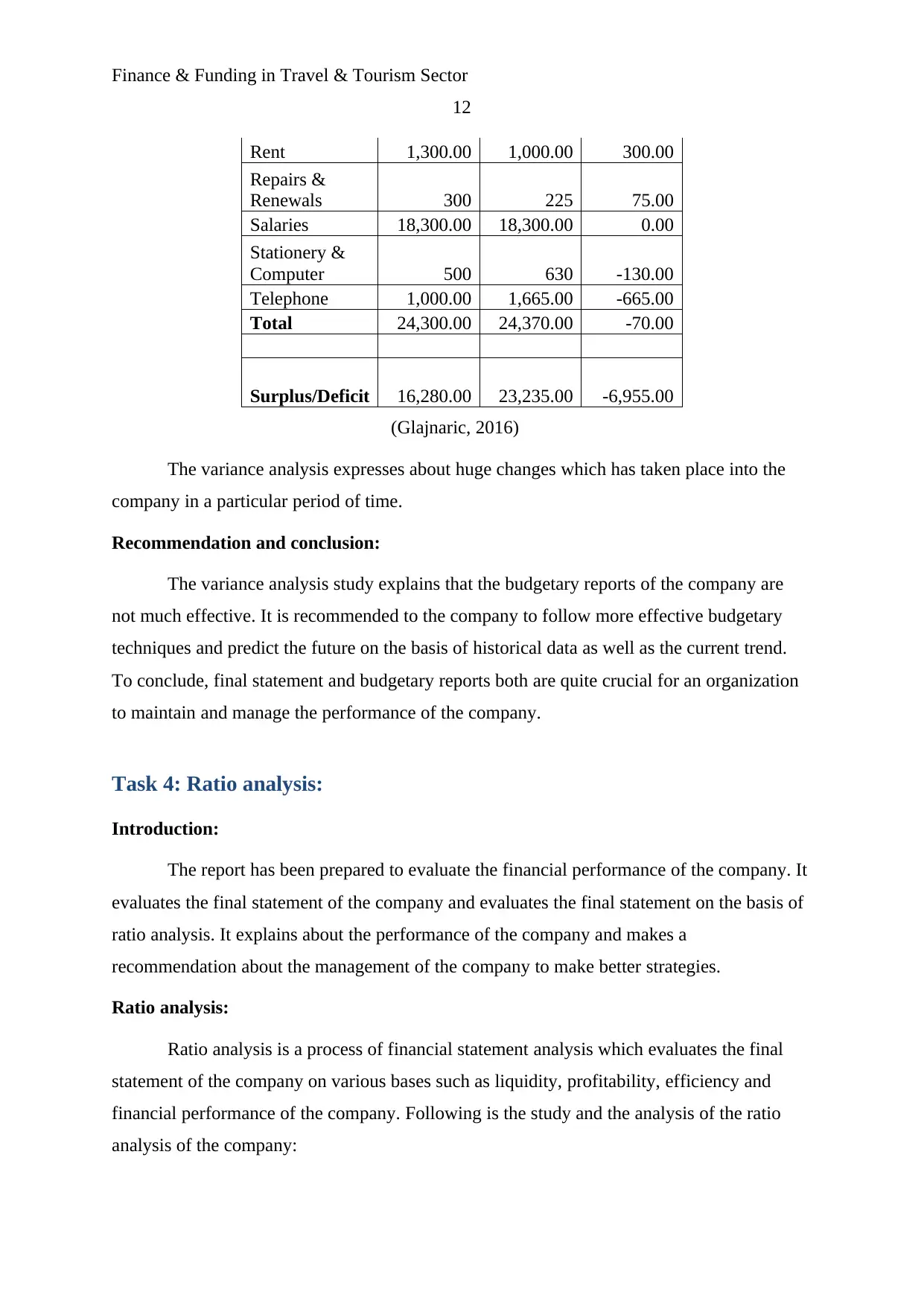
Finance & Funding in Travel & Tourism Sector
12
Rent 1,300.00 1,000.00 300.00
Repairs &
Renewals 300 225 75.00
Salaries 18,300.00 18,300.00 0.00
Stationery &
Computer 500 630 -130.00
Telephone 1,000.00 1,665.00 -665.00
Total 24,300.00 24,370.00 -70.00
Surplus/Deficit 16,280.00 23,235.00 -6,955.00
(Glajnaric, 2016)
The variance analysis expresses about huge changes which has taken place into the
company in a particular period of time.
Recommendation and conclusion:
The variance analysis study explains that the budgetary reports of the company are
not much effective. It is recommended to the company to follow more effective budgetary
techniques and predict the future on the basis of historical data as well as the current trend.
To conclude, final statement and budgetary reports both are quite crucial for an organization
to maintain and manage the performance of the company.
Task 4: Ratio analysis:
Introduction:
The report has been prepared to evaluate the financial performance of the company. It
evaluates the final statement of the company and evaluates the final statement on the basis of
ratio analysis. It explains about the performance of the company and makes a
recommendation about the management of the company to make better strategies.
Ratio analysis:
Ratio analysis is a process of financial statement analysis which evaluates the final
statement of the company on various bases such as liquidity, profitability, efficiency and
financial performance of the company. Following is the study and the analysis of the ratio
analysis of the company:
12
Rent 1,300.00 1,000.00 300.00
Repairs &
Renewals 300 225 75.00
Salaries 18,300.00 18,300.00 0.00
Stationery &
Computer 500 630 -130.00
Telephone 1,000.00 1,665.00 -665.00
Total 24,300.00 24,370.00 -70.00
Surplus/Deficit 16,280.00 23,235.00 -6,955.00
(Glajnaric, 2016)
The variance analysis expresses about huge changes which has taken place into the
company in a particular period of time.
Recommendation and conclusion:
The variance analysis study explains that the budgetary reports of the company are
not much effective. It is recommended to the company to follow more effective budgetary
techniques and predict the future on the basis of historical data as well as the current trend.
To conclude, final statement and budgetary reports both are quite crucial for an organization
to maintain and manage the performance of the company.
Task 4: Ratio analysis:
Introduction:
The report has been prepared to evaluate the financial performance of the company. It
evaluates the final statement of the company and evaluates the final statement on the basis of
ratio analysis. It explains about the performance of the company and makes a
recommendation about the management of the company to make better strategies.
Ratio analysis:
Ratio analysis is a process of financial statement analysis which evaluates the final
statement of the company on various bases such as liquidity, profitability, efficiency and
financial performance of the company. Following is the study and the analysis of the ratio
analysis of the company:
⊘ This is a preview!⊘
Do you want full access?
Subscribe today to unlock all pages.

Trusted by 1+ million students worldwide
1 out of 21
Related Documents
Your All-in-One AI-Powered Toolkit for Academic Success.
+13062052269
info@desklib.com
Available 24*7 on WhatsApp / Email
![[object Object]](/_next/static/media/star-bottom.7253800d.svg)
Unlock your academic potential
Copyright © 2020–2025 A2Z Services. All Rights Reserved. Developed and managed by ZUCOL.




